| |
|
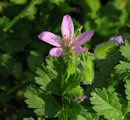 | |
| MaltaWildPlants.com by Stephen Mifsud |

|
| |
|
|
 |  |  |  |
| External Links: |
|
Asphodelus ramosus (Branched Asphodel) |
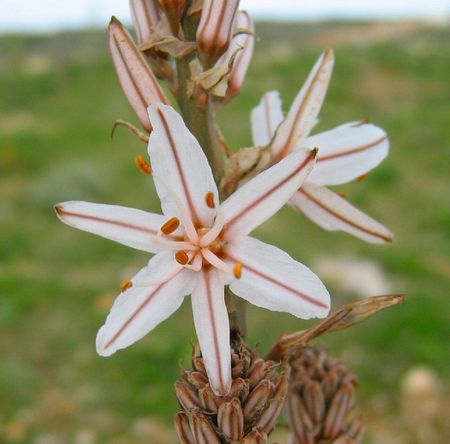
Asphodelus ramosus (XANTHORRHOEACEAE.)
Images for this profile are taken from the Maltese Islands after year 2000. |
|
| Nomenclature |
Species name : | Asphodelus ramosus L. | Authority : | Carl von Linne, Sweden, (1707 - 1778) | Synonyms :
(basionym or principal syn.) |
|
Plant Family : | Xanthorrhoeaceae (= Liliaceae ) (Previously placed in the Asphodelaceae Family)
( Family) | English name(s) : | Branched Asphodel, Common Asphodel | Maltese name(s) : | Berwieq | Status for Malta : | Indigenous. Present on the Maltese islands before man | Name Derivation : |
Asphodelus: apparently asphodel was used to refer a duplicate or copy of a Lily or Daffodil plant (for its close resemblance) but with eaten roots, since the first described plants for this genus did not have much roots, but only tubers. (Greek origin ); 2 = the asphodel, a lily like plant with "eaten" roots, since the plant does not have much roots. (Greek).
ramosus: 1 = meaning branched, with reference for the branched flowering stem (Latin).
| Remarks : | This species was known under the taxon Asphodelus aestivus Brotero for a long period of time and this taxon was misapplied in several other Mediterranean countries. Asphodelus aestivus, which is endemic to Portugal, is similarly branched but differ in having smaller fruit capsules measuring 5-8 mm in length (9-16 mm in A. ramosus) |
|
| Morphology and structure |
PLANT STRUCTURE: |
Character | Growth Form | Branching | Surface |
Description | | | |
General
Picture |  |  |  |
|
LEAVES: |
Character | Arrangement | Attachment | Venation |
Description | | | |
General
Picture | 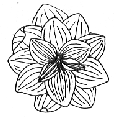 | 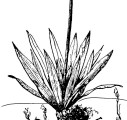 |  |
| |
Character | Leaf Shape | Leaf Margin | Remarks |
Description | | | |
General
Picture | 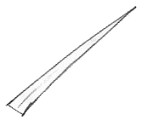 |  |  |
|
FLOWERS: |
Character | Colour | Basic Flower Type | No. of Petals | No. of Sepals |
Description | White (...with a central, longitudinal orange-brown strip. | | 6 To be botanically precise, the flower has 3 sepals (outer whorl) and 3 petals (inner whorl) which are identical, and so they are collectively referred to as 6 tepals or perianth segments. | 0 |
General
Picture | | 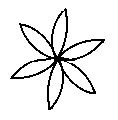 |  |  |
| |
Character | Inflorescence | Description | Ovary | Stamens |
Description | | The flower consists of 6 elongated, wax-white petals, 6 conspicuously long, anthers composed of a white firm filament and an orange anther, 1 white, central style + stigma (little longer than the stamens) and a central and superior ovary which is enclosed by a an orange/salmon cap. | | |
General
Picture |  |  | 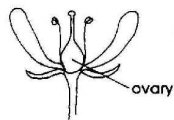 | 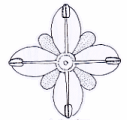 |
| |
Character | Scent | Average Flower Size | Pollen Colour | Other Notes |
Description | YES Mild, sweet. honey-like fragrance which may be missed in the open air. | 35 mm | Bright Orange | - |
|
SEEDS: |
Character | No. Per Fruit | Shape | Size | Colour |
Description | 6 (maximum capacity). | Spear-head | 5mm x 3mm (L x W). | Black with tiny white specs |
General
Picture |  |  |  |  |
|
FRUIT AND OTHER BOTANICAL DATA: |
Character | Fruit Type | Colour of Fruit | Subterranean Parts | Other Notes |
Description | | Green Initially it is yellow/brown but turns green on maturation and straw-yellow when fully ripe. | | - |
General
Picture | 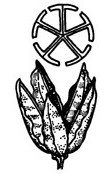 |  | 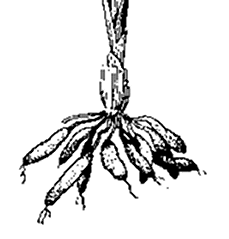 |  |
|
|
| Plant description and characters | |
Life Cycle: | Perennial. |
Growth Form: | GEOPHYTE (bearing underground bulbs, rhizomes, stolons, etc.) |
Habitat: | Steppe |
Frequency: | Very Common |
Localities in Malta: | Very Common and found throughout the Maltese Islands such as at Dingli, Mtahleb, Ghajn Tuffieha, Mellieha, Delimara, Mistra and Ta' Cenc just to mention a few examples. |
Plant Height: | 50-150cm. |
| Jan-Apr |
Protection in Malta: | Not legally protected till the last update of this website (2/Mar/2022) |
Red List 1989: | Not listed in the Red Data Book of the Maltese Islands |
Poison: | |
This monocot is a tough perennial which grows from underground tubers that lack extensive rooting. It withstand wind, cold, dryness and poor nutrient soil, and therefore, one of its preferred habitats are rocky cliff tops, steppe and garigues.
The plant have several long basal leaves which grow randomly from the underground tuber outwards. The grey-green leaves are sword shaped - 35-45cm long and only 3 cm wide - with their smooth edges tapering gradually to a pointed but not spiny tip. The cross section of the leaf is V shaped, with a slightly bulging midrib at the underside. In mid winter, an erect flowering stem starts growing from the center of the leaf outgrowths and this flowers in late Winter. The stem may reach up to 150cm in height or remain low at about 50cm, depending environmental conditions. The flowering stem is glabrous, and produce branched flower clusters in panicles, hence forming a pyramidal form of inflorescence. The cluster is loosely branched at the lower end and gradually gets simpler toward the upper end.
Flowers are held to the branched flowering stalks by 10mm long pedicels. In every cluster, the bottom flower opens first and slowly the flowers above blooms one by one. Every single flower remains in bloom for several days. The flower buds are made from the petals itself, since they do not have any true sepals. Buds are white with reddish-brown vertical stripes.
When the buds open up, the produce a flower with 6 wax-white, slightly elongated petals that have a central reddish-brown mid-vein. The most noticable part is however the 6 stamens which rise firmly up to about 18mm. Each stamen has a white erect filament and a brown anther covered with bright orange pollen. The central and single style+stigma is slightly longer than the anther, at about 20mm length. Flower measures up to 32-40mm accross and about 30mm in length from the base to the stigma.
The flower give the false impression that the colour of the ovary is salmon coloured. Actually, the inferior ovary is green but it is enclosed by a pale orange to salmon colored cap which is formed by 6 flaps, each coming from the base of every stamen. The ovaries form into the fruit being a green dehiscent capsule, the size of a pea (7mm c.) and splits open into 3 parts when the seeds are ripe at the end of May. The spear-head shaped seeds are black with tiny, white specs, 5mm x 3mm in size and maximum of 6 seeds per fruit capsule.
|
|
| Information, uses and other details |
Nativity and Distribution
This plant is native to Africa and most of the Mediterranean coasts which include [WWW-26] :
- Spain +Canary Islands
- Northern Africa: Algeria ; Egypt; Libya; Morocco
- Western Asia: Cyprus; Egypt - Sinai; Iraq; Israel; Jordan; Lebanon; Syria; Turkey
- Southeastern Europe: Albania; Greece (incl. Crete) ; Italy (incl. Sardinia, Sicily)
- Southwestern Europe: France (incl. Corsica} ; Portugal; Spain (incl. Baleares)
Derivation of the Genus name - Asphodelus
According to an Italian site [WWW-47] Asphodelus comes from a composite Greek world as indicated below:
a = non;
spodos = ashes;
edos = valley;
So it means a valley of the remainings that has not been destroyed to ashes by fire. The name is associated with the fact that this plant's underground tubers are somehow not much harmed by accidental fire, and so, these resistant tubers will quickly forms back the plant in life. So after some time, what remains after a fire are these surviving asphodelus plants.
Another reference [WWW-03] have a completely different version, but also Greek in origin.
The ancients planted the flowers near tombs, regarding them as the form of food preferred by the dead, and many poems refer to this custom.
The name is derived from a Greek word meaning sceptre.
Propagation
Germination from seed usually takes place in 1 - 3 months at 15C [134] . When they are large enough to handle, prick the seedlings out into individual pots and grow them on in the greenhouse for at least their first winter. When the plants are large enough to handle, plant them out into their permanent positions in late spring or early summer.
Division in early spring or autumn [111] .
Cultivation details
Succeeds in ordinary garden soil, tolerating partial shade [200] . Requires a well-drained soil [1, 200] . Prefers a deep, rich in sand, loamy soil [1, 111] , in a sunny position and a soil that is not too rich in nutrients [200] . Grows well on hot dry banks [42] .
This species is not hardy in the colder areas of the country, it tolerates temperatures down to between -5 and -10°C [200] .
Plants are evergreen in mild winters [200] .
Plants seem to be immune to the predations of rabbits [233] .
Edible Uses
The Root (tuber); Seeds and Stem are been reported to be eaten in the past.
The Tuber can be eaten cooked [4] . It is rich in starch [89, 177] . If dried and boiled in water it yields a mucilaginous matter which can be mixed with grain to make a nutritious bread [4, 105] . Boiling destroys the acrid principle in the tubers [4] , rendering them quite pleasant to eat [KF] .
The flowering stalk can also be cooked and eaten [89, 148] .
Seeds can be eaten roasted [89, 148] .
It was also reported that the leaves have been used in the production of a type of cheese specifically in "Rignano Garganico" in Italy [WWW-47]
Medicinal Uses
The root, gathered at the end of its first year, is acrid, antispasmodic, diuretic, emmenagogue [4] . The bruised root has been recommended for rapidly dissolving scrofulous swellings. [WWW-03] It was used in the treatment of several diseases by the Greeks and Romans, but is not employed in modern medicine [4] .
| Acrid |
Sharp and harsh, or bitter to the taste; pungent; causing heat and irritation. [WWW-32] |
| Antispasmodic |
Used to relieve or prevent spasms (especially of the smooth muscles) [WWW-32] |
| Diuretic |
Tends to increase the flow of urine [WWW-32] |
| Emmenagogue |
Promotes the menstrual discharge in women.
[WWW-32] |
Another medicinal use which is not further practiced nowadays was that for treating dermatitis and sun burns. An extract was obtained from the first tubers gathered in the dry months of late Summer. A decoction of 5 gr in 100 ml water was applied with the use of handkerchiefs to the effected area on the skin. [WWW-47]
Other Uses
In Persia, glue is made with the bulbs, which are first dried and then pulverized. When mixed with cold water, the powder swells and forms a strong glue.
[4] that is used by bookmakers and shoemakers [61, 89, 148] .
A yellow dye is obtained from the tuber [46, 61] .
Significance of Asphodelus
The presence of the Asphodel is often a sign of overgrazed ground since the plant is not usually eaten by animals. [274] It is also an indication of poor nutrient soil, since it is one of the few plants prefers poor disturbed ground. In addition, the branched asphodel can serve as a sign of environmental or ambient degradation, since the soil is getting less in quantity and nutrients. [WWW-47] It is quite difficult to find large populations of Asphodels where there is rich vegetation or trees and the habitat is undisturbed [SM] As discussed previously, it also indicate that there was a fire in the surrounding area since the underground tubers resist such an incidence. It is particularly abundant in steppe and abandoned fields. [WWW-47] .
Personal Observations
Botanical information about the tepals
Generally the species of the Asphodelaceae are described by non-botanical lterature to have six petals and no sepals. However, the flowers have two whorls of 3 sepals and 3 petals which are almost identical to each other giving the appearance of 6 similar petals. They are referred to as tepals because strictly speaking, three of them are actually sepals not petals. For example in Asphodelus ramosus, three tepals are slightly more broad than the other alternating tepals and they correspond to the 'sepals' [SM] The definition of a tepal is: A perianth segment in a flower in which all the perianth segments are similar in appearance. [WWW-32]
The other similar Asphodelus species in Malta
Another Asphodelus species - A. fistulosus (Onion Weed) - is present in the Maltese islands. It is rare but somewhat more frequent in Gozo. A. fistulosus is distinctly a smaller, unbranched plant, with rather similar but smaller flowers. The table below compares botanical characteristics between the two Asphodelus species occurring in the Maltese Islands. [SM]
| Feature |
Asphodelus ramosus |
Asphodelus fistulosus |
| Occurence in Malta |
Common |
Rare |
| Length of plant |
100-150cm |
30-50cm |
| Shape and length of Leaves |
Ensiform, 45cm c. |
Linear, 25cm c. |
| Branching of the flower stalk |
Profusely branched |
Unbranched or one to a few small branches at the base |
| Flower colour |
Petals white with a light brown / apricot coloured central stripe |
Petals white with a pinkish to pale brown central stripe |
| Stamens |
6, erect, 25mm long |
6, drooping down, 10mm long |
| Anther colour |
Bright Orange |
Brown |
| Stigma |
Simple, white |
Divided into 3 inflated structures, bright pink |
| Fruit |
Orange-brown, 10-15mm long |
Orange-brown, < 7 mm long |
|
|
| Links & Further literature
(0 papers) |

Google Web |

Google Images |

Google Scholar |

Research Gate |

Wikipedia |

JSTOR |

GBIF |

Med Checklist |

Cat. of Life |

EoL |

IPNI |

World Flora Online |

Plants of the World Online |

Vienna Virt. Herb. |

RBGE Herbarium |

KEW Herbarium |

MNHN |

Arkive |

IUCN |

CABI |
Kindly Email if there are papers and publications about local
studies or information about this species to be included in the list above.
|
| Photo Gallery (31 Images) |  |
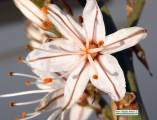 |
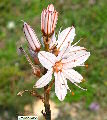 |
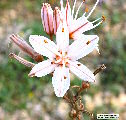 |
IMAGE: ASPRM-01 Close up photo of flower in situ. |
IMAGE: ASPRM-02 Photo of flower in situ, composed of 6 white tepals with a central reddish brown stripe (mid-vein). |
IMAGE: ASPRM-03 Photo of flower and its conspicuous 6 firm stamens with orange anthers and a central style. |
IMAGE: ASPRM-04 Close up photo of flower in early April. |
 |
 |
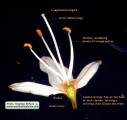 |
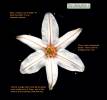 |
IMAGE: ASPRM-05 Photo of flower at an angle to show better the long stamens. |
IMAGE: ASPRM-06 Multi branched panicle forming pyramidical clusters of flowers. The lower flowers are the one to open first, and gradually, the ones above open up. |
IMAGE: ASPRM-07 Scanned image of a flower dissected transversely. Note the flap like structure making the salmon/orange covering shell around the green, inferior, central ovary. |
IMAGE: ASPRM-08 Flower with the stamens and style dissected out. Note the green ovary partially covered by a salmon/orange covering. |
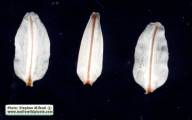 |
 |
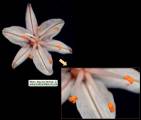 |
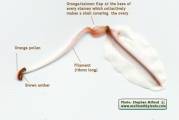 |
IMAGE: ASPRM-09 Scanned image of dissected petals. Note that some petals are more broad. Every flower have 3 broad and 3 normal petals arranged alternately. |
IMAGE: ASPRM-10 Close up photo of stamens in situ. Not many flowers have orange pollen. |
IMAGE: ASPRM-11 Magnified scanned image of the anthers producing large amounts of orange pollen. |
IMAGE: ASPRM-12 Dissection of one stamen. Note the salmon/orange flap at the base of the stamens' filament. |
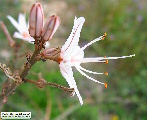 |
 |
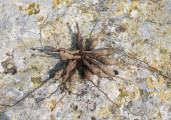 |
 |
IMAGE: ASPRM-13 Photo of plant (lateral view) in situ showing the long stamens and white style with slightly swollen stigma. |
IMAGE: ASPRM-14 Scanned image of a bud - bullet shaped, and white coloured with vertical reddish-brown stripes. |
IMAGE: ASPRM-15 Photo of the numerous, underground root tubers of the plant. |
IMAGE: ASPRM-16 Photo of plant or proably 2 plants growing very near to each other since normally, there is only one flowering stalk per plant. (Dingli, March-2005). |
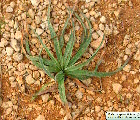 |
 |
 |
 |
IMAGE: ASPRM-17 Photo of a young plant consisting of a rosette of basal, sword shaped leaves. |
IMAGE: ASPRM-18 Photo of adult plant, with plenty of basal, sword-like leaves and a tall flowering stem. |
IMAGE: ASPRM-19 Photo of plant growin in a soily habitat at Ghajn Tuffieha. |
IMAGE: ASPRM-20 Habitat of plant, rocky cliff tops with little soil. |
 |
 |
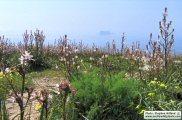 |
 |
IMAGE: ASPRM-21 Photo of many flowering plants on the garigue of Siggiewi (beside Ghar Lapsi) taken on April 2005. |
IMAGE: ASPRM-22 Photo of an adult plant (Mar 2005). |
IMAGE: ASPRM-23 Photo of several plants on the garigue of Qrendi, (beside Hagar Qim) taken on April 2005 with the islet of Filfla at the background. |
IMAGE: ASPRM-24 Photo of the flowering plant aginst the background of the blue Mediterrenean Sea. |
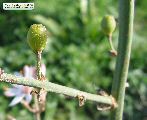 |
 |
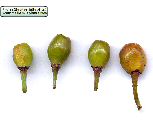 |
 |
IMAGE: ASPRM-25 Photo of fruit in situ - green, globular/ovoid capsules. |
IMAGE: ASPRM-26 Photo of several casules arranged alternately along flower stalk. |
IMAGE: ASPRM-27 Scanned image of fruit - hairless, green capsules, ovoid-spherical in shape and an average size of 10mm x 7mm. With maturation, the colour start getting yellow and then brown. |
IMAGE: ASPRM-28 Transverse section through fruit showing 6 whitish seeds being developed. |
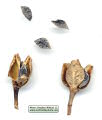 |
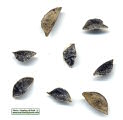 |
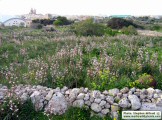 |
| IMAGE: ASPRM-29 Scanned image of mature seed capsules split open into 3 parts to release their black seeds (maximum of 6 seeds per capsule). |
IMAGE: ASPRM-30 Scanned image of black seeds with several tiny, white specs. |
IMAGE: ASPRM-31 Photo of a garigue in Dingli with many Asphodelus aestivus plants (Mar 2005). |
IMAGE: ASPRM-32 |
|
| | |

